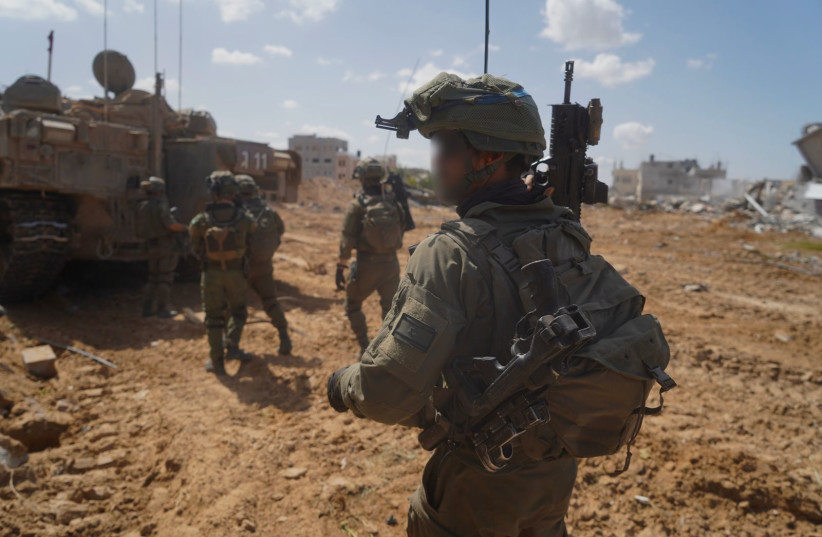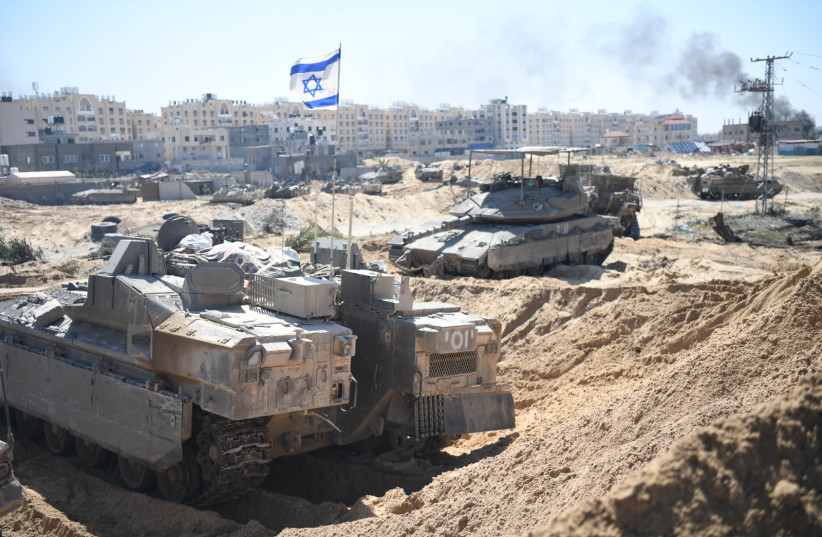IDF’s Southern Command defined the raid of the Hamad neighborhood in Khan Yunis as one of the most creative maneuvers of the war in Gaza.
The Israeli forces reached operational success quickly, surrounding the neighborhood within 15 minutes. Israeli forces led by the IDF's 98th Brigade also captured two prominent senior Hamas figures during the operation.
The story behind IDF's success in Hamad
Following Operation Protective Edge in 2014, during which the IDF began destroying Hamas terror tunnels and terror infrastructure, Qatari Emir Tamim bin Hamad al-Thani decided to donate hundreds of millions of dollars for the reconstruction of the Gaza Strip.
A considerable amount of the Emir’s funds was invested in establishing “Hamad City,” a luxurious neighborhood within Khan Yunis. The upscale neighborhood consisted of 124 six-floor buildings with 1060 apartment units, a mosque, two schools, and parks. With the leftover funds, the Emir contributed to the construction of a hospital.
Hamas senior officials and their families moved into this new and opulent neighborhood, which then turned into ruins after the IDF entered as part of the ground operation to dismantle Hamas terror infrastructure in the area.

At the height of IDF operations in Khan Yunis earlier this year, the Shin Bet (Israel Security Agency) revealed a concentration of senior operatives hidden within Hamad City. These included valuable assets for understanding the area, uncovering Hamas's military infrastructure, and information regarding the hostages.
Shin Bet officials made it clear to the commanders in the Southern Command that there were more than 10,000 Palestinians in the area who thought that the neighborhood was protected from attacks for a number of reasons, which include the fact that it was established with Qatari funding and that the IDF had not operated in it except for several airstrikes at the beginning of the ground invasion.
"It was clear to us that there was a high concentration of armed men there and that there were intelligence assets there that we wanted with us," said a military official involved in planning the operation on the neighborhood.
The architectural plan of the neighborhood was laid out before Brig.-Gen. Dan Goldfus, OC Givati Brigade Col. Liran Batito, OC 7th Brigade Col. Elad Tzuri, and OC Commander Brigade Col. Omer Cohen. Together, they planned the ruse that would serve as the basis of the operation and achieve its objectives.
Shin Bet clarified that, although the remaining terrorists did not operate in battalion or platoon formations, they possessed significant command capabilities and extensive combat resources, including tunnel infrastructure.
"The ability of the terrorists in the neighborhood to carry out an organized attack on the forces is low. However, they pose a tangible threat with anti-tank missiles, numerous explosives, sniper rifles, and fortified positions, operating amid civilian buildings, heavily armed,” explained one of the security officials who accompanied the troops.
“While terrorists may potentially be regrouped in a building, they do not necessarily collaborate, and sought refuge in the assumption that the neighborhood was protected and would not be targeted by the IDF.”
Goldfus determined the operation's tactics. After unit commanders approved the required precision and speed, special forces, including Shayetet 13, conducted military drills in construction sites in Ofakim and Netivot.
“The operational idea involved a swift multi-directional assault, including a siege, with rapid timing, making accuracy critical,” a security official said.
Goldfus decided that despite the desire for secrecy, tank units from the 7th Brigade and Givati's reconnaissance vehicles would be deployed early on to more significantly impact the terrorists in hiding. In addition, geographical points were set for rapid troop arrival in less than 20 minutes.
One commando officer described a curtain of fire before the swift incursion. "If you weren't there and didn't see the fire up front, you wouldn't understand how accurate it was. Egoz went in when the first phase of the maneuver was at its peak.
The combination of the ground maneuver and the fire left no possibility for the terrorists to escape, not even underground. As soon as they raised their heads, they realized It was too late."
The terrorists had no idea what was coming for them
Within 15 minutes, a speed later praised by the Southern Command, the siege was completed.
Special forces signaled their secure positions, prompting the deployment of drones with powerful speakers, urging Palestinians to move south towards the "enclosure." Over 300 terrorists, including Hamas terrorists, were identified through the "enclosure," many from different areas of Gaza.
"When terrorists tried to escape areas not defined as 'enclosures,' tanks or unmanned aerial vehicles fired at them," explained a senior officer. "Nearly twenty armed terrorists were killed within the first twenty minutes. All forces acted in unison. Some entered the northern part of the neighborhood, targeting enemy concentrations. We opened a seven to six-minute barrage, including 55 airstrikes. The neighborhood was sealed off."
Shin Bet officials reported that terrorists were surprised by the IDF's arrival and penetration into the heart of the neighborhood.
Ostensibly, the neighborhood was supposed to be devoid of civilians, as an evacuation operation had relocated residents from Khan Yunis to shelters in Rafah and south of the Gaza River.
The operation to seize buildings was preceded by intelligence work of Shin Bet officers who led the forces.
"They sat with the informants in the field. One map is in Hebrew, and the other is in Arabic, extracting significant information about what is happening in the buildings. They pinpointed findings, and a Shin Bet investigator translated and explained their location. The information was passed to my coordinator, who guided the commando units. Every few hours, a situation assessment was conducted, and information from the field informants was relayed to the troops," a senior officer recounted.
"This way, every unit knew where they were going and what awaited them. On what floor, how many terrorists, what weaponry, and where the explosives were kept? Some areas had RPGs; others had mines. Hence, the encirclement was swift."
Despite public criticism of the slow progress in Khan Yunis, it was decided to carry out the seizure of buildings in stages according to a top-down directive, which included engineering activities with a bulldozer, drone scanning, followed by attack dogs, and only then entry with fire and subsequent visual scanning.
In some cases, terrorists surrendered peacefully when confronted by the attack dogs, while in others, they opened fire at the forces.
Initially, in the densely populated neighborhood, the fighting focused on terrorist concentrations, and later encounters were at close range. Reconnaissance units like Givati, Maglan, Egoz, and Shayetet 13 encountered armed terrorists, anti-aircraft missiles, and mines at point-blank range.
"In some cases, close encounters ended with terrorists killed by our small arms fire, while in others, they retreated, and our forces dealt with tanks, aircraft, or missiles. In some cases, they were attacked in apartments. When a fire broke out in an apartment, they climbed to the roof to escape, only to be targeted by combat helicopters. Nearly sixty terrorists were killed in close-range encounters," a senior officer from 98th Brigade explained. "It was combined arms warfare - artillery, engineering, infantry, commandos, air force, and intelligence."
The aerial support was divided into two main operations. Combat unit commanders submitted targets for airstrikes within 24 hours of the request. Throughout the operation, there were over 150 combat targets.
Additionally, there were flash targets: a brigade commander's demand to attack a target by combat aircraft within twenty minutes. The pace was relentless, yet within a few days, the commando brigade criticized the low availability of aircraft.
"The findings in the apartments were diverse. In some, we found a variety of weapons suitable for an armory. Weapons of all types, explosives, mines, grenades, missiles. In some places, they hid behind walls and furniture. In some places, they waited with thirty to ten terrorists, and in some apartments, there were lone terrorists," the senior officer recounted.
"There were apartments with three bomb zones. The entire floor was booby-trapped. In one case, a terrorist thought that the engineering activity in the building included our fighters and thus triggered a bomb zone, causing the entire floor to explode and disappear. They tried to hide explosives in electrical cabinets, elevator shafts, and other hiding places to use against our forces. There were places where they decided to fight to the end, and terrorists went out of windows to launch anti-tank missiles and rockets. In one case, a terrorist exited one of the buildings and ran to attach an explosive charge to a Tiger APC. A quick response from the force killed him en route. Most terrorists surrendered because they realized they were surrounded from all sides and had no choice, but some terrorists fought until the end. Until death."

A little piece of paper provides a large amount of information
Within the commando brigade, other exceptional events were pointed out during the combat in the area.
In one incident, soldiers from the Oz Brigade climbed to an apartment on the fourth floor of a building. During the encounter, one of the soldiers saw a mother sitting with her hands tied and her daughters in front and behind her while a terrorist cruelly opened fire in multiple directions without hesitation or concern for harming them.
The unit managed to eliminate the terrorists and provide rapid medical assistance to the mother and her daughters.
The next stage was the subterranean warfare, constructed beneath the upscale neighborhood. A tunnel was dug under the parks, buildings, and mosque, leading southward. With intelligence assistance from the field and investigations, the IDF cut it off to prevent escape, then began dealing with it by mapping and destroying it.
Two soldiers were killed and over twenty injured in the Hamad City operation. The pertinent question arose as to why the buildings were not bombed from the air to avoid risking IDF soldiers.
Officers in the 98th Brigade did not hesitate. They clarified that it was necessary to enter the neighborhood, as terrorists coerced civilians with weapons and threats to stay in their apartments.
It was also clarified that items related to the issue of prisoners and missing persons were found.
In one of them, one of the investigated terrorists pointed out an apartment where the personal weapon of Lt.-Col. Yehonatan Steinberg, who was killed in action on October 7, was found.
Another point highlighted by a senior officer from the 98th Brigade was the loot collected from the apartments. "It's a psychological process, in my opinion. You can enter a house to bring a phone or a sheet, and this crumpled sheet in the closet can shed light and close circles and ends about tunnels and caves — where and how they are built, what the building layers are, and how to enter the tunnel. It is a foolish drawing that closes the corner for you and makes you understand intelligence better."
Towards the end of the conversation, the senior officer from the 98th Brigade said that, in his estimation, the story of the fight against Hamas terrorists and other terrorist organizations is a matter of spirit.
In his view, Hamas forces are exhausted and suffer from food and ammunition shortages and the intensity of combat.
Most of them hide underground or in hiding apartments, hoping that the fighting will end.
Therefore, in his view, if the Israeli side shows resilience against the difficulty and has patience, Hamas could be decisively defeated without intense fighting as at the beginning of the war, and more surrendering terrorists could be seen.
